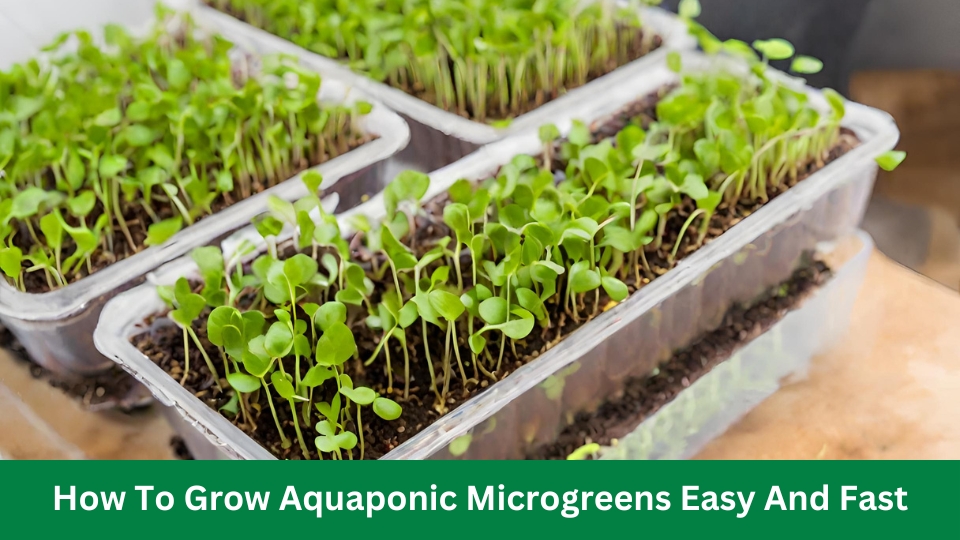Aquaponic microgreens provide a sustainable and efficient method of growing nutrient-dense greens. Aquaponics offers a unique approach that combines aquaculture and hydroponics to create a symbiotic system for cultivating fresh and nutritious microgreens.
Plants receive essential nutrients by utilizing fish waste in the aquaculture component, resulting in rapid growth and higher nutrient content. This method conserves water and eliminates synthetic fertilizers and pesticides.
With the ability to grow a wide variety of microgreens year-round, aquaponics is an ideal solution for individuals and businesses seeking a sustainable and organic source of these flavorful and nutritious greens.
Aquaponics: An Overview
Aquaponic microgreens are a sustainable farming method that combines aquaculture and hydroponics. It involves growing nutrient-rich microgreens on top of a fish tank, creating a mutually beneficial relationship between the plants and the fish. This technique offers a highly efficient and eco-friendly way to produce fresh and healthy greens all year round.
Aquaponics is a sustainable agricultural system combining aquaculture (fish cultivation) with hydroponics (growing plants in water). It is an innovative, eco-friendly approach that harnesses nature’s power to create a self-sustaining ecosystem.
In an aquaponic system, fish waste provides nutrients for the plants, while the plants naturally filter and purify the water for the fish. This symbiotic relationship between fish and plants produces a bountiful harvest of fresh and nutritious produce. This makes aquaponics a popular choice for urban farming and sustainable agriculture.
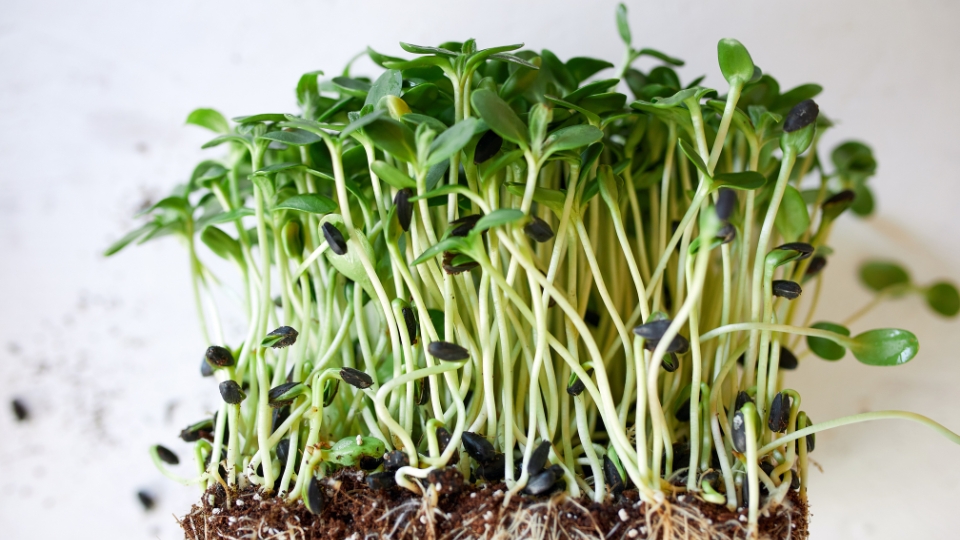
Aquaponics Vs. Hydroponics
While both aquaponics and hydroponics involve growing plants without soil, there are key differences between the two systems.
Aquaponics
In aquaponics, the waste generated by fish is used as a nutrient-rich fertilizer for the plants. Fish waste contains ammonia, converted into nitrites and nitrates by beneficial bacteria in the system. These nitrates serve as the primary source of nutrients for the plants.
The plants, in turn, act as a biofilter, removing excess nutrients from the water and creating a healthier environment for the fish. This natural nutrient cycling process eliminates synthetic fertilizers, making aquaponics an organic and sustainable cultivation method.
Hydroponics
Hydroponics, on the other hand, relies on nutrient solutions in water to provide essential nutrients directly to the plants. Hydroponic systems grow plants in an inert growing medium like perlite, rock wool, or coconut coir. The nutrient solution is carefully balanced to meet the plant’s specific needs, ensuring it receives all nutrients for healthy growth.
Unlike aquaponics, hydroponics does not utilize fish or organic waste. Instead, it relies on artificial nutrient solutions, which can be adjusted based on plant varieties’ requirements.
The choice between aquaponics and hydroponics depends on various factors, including the grower’s goals, available resources, and desired environmental impact. While both systems offer efficient ways to grow plants, aquaponics also offers fish cultivation and nutrient recycling. This makes it a more sustainable and holistic approach.
Table: Aquaponics vs Hydroponics
| Aquaponics | Hydroponics |
|---|---|
| Utilizes fish waste as a nutrient source | Relies on artificial nutrient solutions |
| Creates a symbiotic relationship between fish and plants | Plants grow directly in an inert medium |
| Natural nutrient cycling process | Precise nutrient control |
| Organic and sustainable | Requires synthetic fertilizers |
By understanding the differences between aquaponics and hydroponics, you can decide which method is best suited for your needs. Whether you value the integrated ecosystem of aquaponics or the precise control of hydroponics, both systems offer innovative and efficient ways to grow plants in a soilless environment.
Choosing The Right Microgreens For Aquaponics
Discover the perfect aquaponic microgreens for your system with our comprehensive guide, ensuring optimal growth and nutrient-rich harvests.
Microgreens are a fantastic aquaponics addition. These tiny nutrient-packed greens offer many health benefits and are easy to grow. However, selecting the right microgreens for your aquaponic system ensures successful growth and a bountiful harvest. This blog post will discuss the key factors to consider when choosing microgreens for aquaponics.
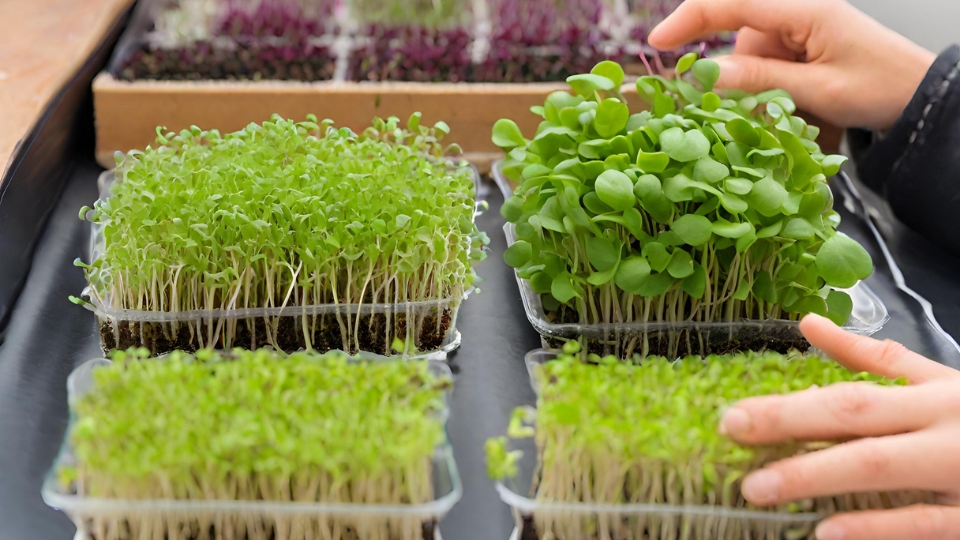
Planting
Planting microgreens in your aquaponic system requires attention to detail. Please start by selecting the appropriate containers or trays for your microgreens, ensuring proper drainage. Fill the containers with a high-quality soil mix with adequate aeration and moisture retention.
Soil Mixing
The right soil mix is essential for the successful growth of microgreens. Prepare a well-draining mix by combining organic potting soil, cocoa coir, and perlite or vermiculite in equal parts. This mixture provides the nutrients and drainage necessary for healthy microgreens.
Seeds
Choosing high-quality seeds is paramount to thriving microgreens in your aquaponic system. Look for organic, non-GMO seeds labeled for microgreen production. Aquaponic microgreen varieties include kale, broccoli, arugula, radish, and mustard greens. It is recommended to source seeds from reputable suppliers to guarantee their viability and germination rate.
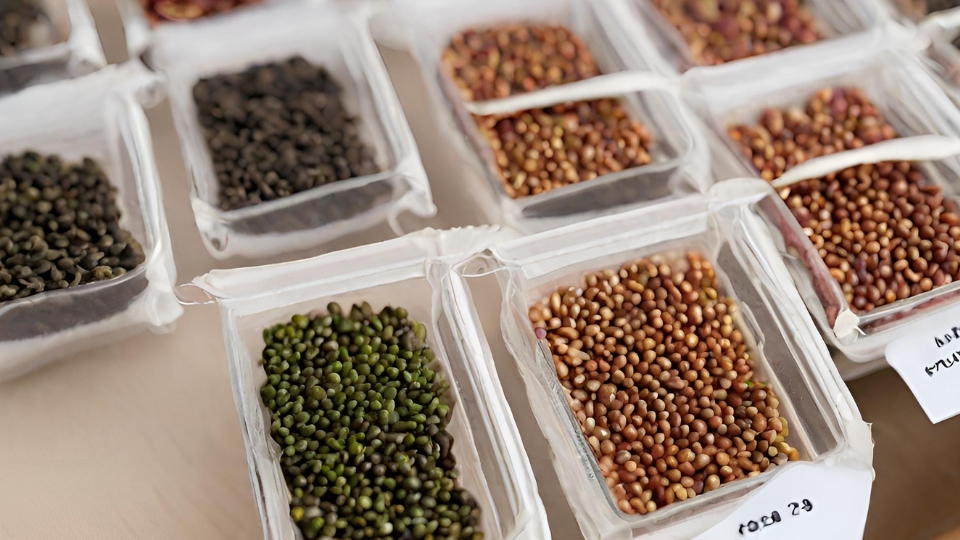
Watering
Watering your microgreens in an aquaponic system requires a delicate balance. Once you have planted the seeds, keeping the soil moist but not waterlogged is crucial. Overwatering can cause root rot, negatively impacting microgreen growth and health. Monitor moisture levels regularly and adjust watering schedules accordingly.
To enhance microgreen growth in your aquaponic system, maintain an optimal temperature range between 60-75°F. Use grow lights or natural sunlight to provide adequate lighting, especially during germination. Regularly inspect your microgreens for pests or diseases and promptly address any issues that may arise.
Remember, each microgreen variety has unique requirements, so it’s essential to research and understand the specific needs of the greens you wish to grow in your aquaponic system. By adhering to these guidelines and selecting the right microgreens, you can enjoy an abundant harvest of delicious and nutritious greens year-round.
Caring For Aquaponic Microgreens
When caring for aquaponic microgreens, specific tasks must be done daily, weekly, and monthly. By following this care routine, you can ensure your microgreens’ health and growth, maximizing their yield and quality. This section will guide you through the daily, weekly, and monthly care steps essential for maintaining thriving aquaponic microgreens.
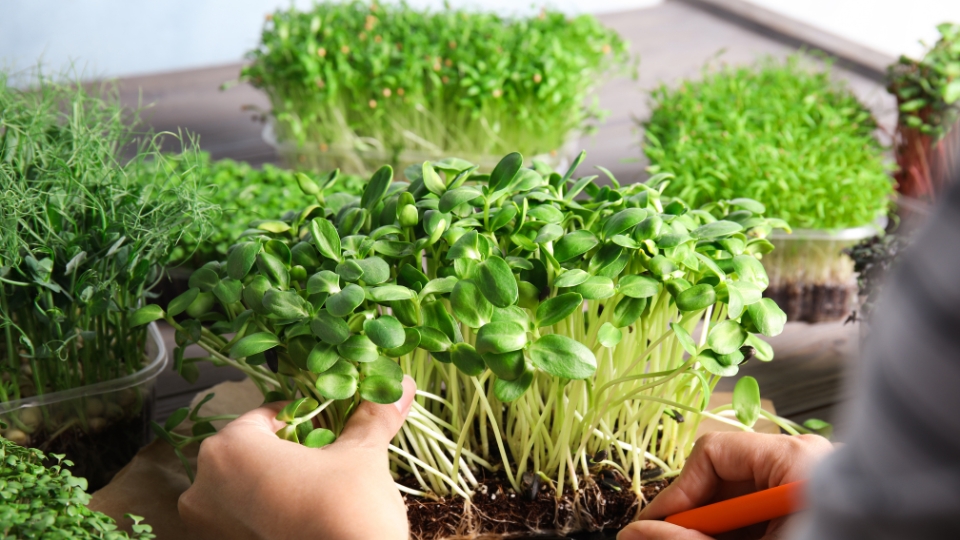
Daily Care
1. Observe your aquaponics system’s water levels daily, ensuring they are appropriate for both the fish and the plants. Too much or too little water can stress microgreens, affecting their growth and development.
2. Check nutrient levels regularly using a water testing kit. This will help you ensure microgreens receive nutrients for optimal growth. Adjust nutrient levels as needed to maintain an ideal balance.
3. Inspect the microgreens for any signs of pests or diseases. Early detection prevents pests or diseases from harming your entire crop. Remove any affected plants or take appropriate measures to control the problem.
Weekly Care
1. Prune and trim the microgreens as needed. This helps maintain their shape and encourages new growth. Regular pruning also prevents overcrowding, inhibiting air circulation and increasing disease risk.
2. Check and clean aquaponic filters. Filters are crucial to maintaining water quality by removing waste and debris. Clean them weekly to prevent clogging and ensure system efficiency.
3. Inspect and clean the grow bed. Remove any dead leaves, debris, or uneaten fish food that may have accumulated. This helps maintain a clean and healthy environment for the microgreens.
Monthly Care
1. Flush the system to remove excess nutrients and prevent the buildup of toxins. This helps maintain water quality and prevents nutrient imbalances that could harm microgreens and fish.
2. Inspect the pumps and plumbing for any wear or damage. Replace or repair any faulty components to ensure the aquaponics system’s proper functioning.
3. Monitor your microgreens’ growth and health over a month. Take note of any changes or issues, and make necessary adjustments to the care routine to address specific needs or challenges.
Harvesting And Using Aquaponic Microgreens
Growing microgreens using aquaponics can be a rewarding and sustainable way to add fresh, nutrient-rich greens to your diet. Once your microgreens have reached the desired size, it’s time to harvest and make the most of these delicious greens. This section will discuss harvesting, storing, and selling aquaponic microgreens.

Harvesting
Harvesting your aquaponic microgreens at the right time is crucial to ensure they are at their peak flavor and nutritional value. When the greens have grown to about 1-2 inches in height and have developed their first set of true leaves, it’s time to harvest them.
Here is a simple step-by-step guide to harvesting your aquaponic microgreens:
- Prepare a clean pair of scissors or a sharp knife.
- Gently grab a handful of microgreens near the base.
- Cut the microgreens just above the root level using your scissors or knife.
- Repeat this process for the rest of the microgreens.
Remember to handle the microgreens with care to avoid damaging the delicate leaves. Once harvested, gently rinse the microgreens with water to remove any dirt or debris.
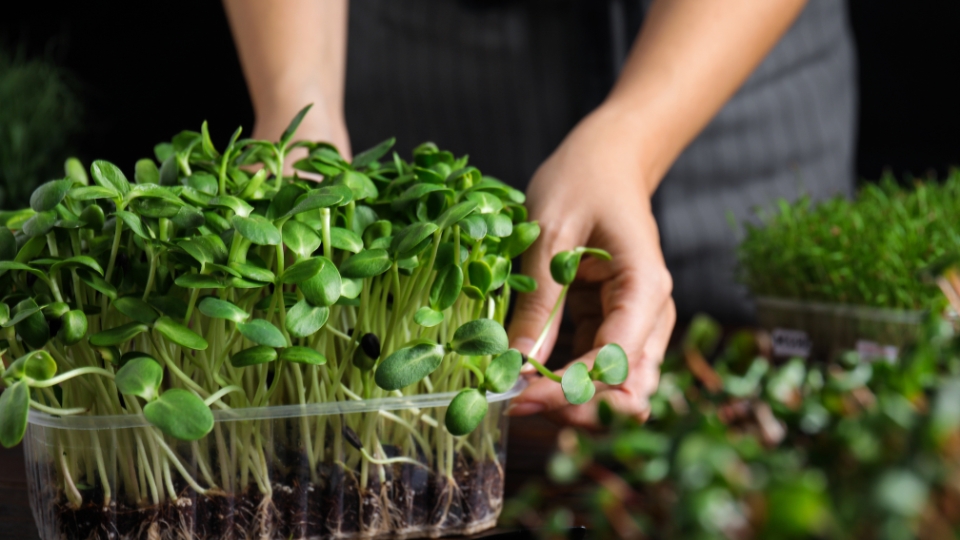
Storing
Proper storage is essential to maintain the quality and freshness of your harvested aquaponic microgreens. After rinsing, follow these storage tips:
- Wrap the microgreens in a damp paper towel.
- Please place them in a sealable plastic bag, leaving a small opening for air circulation.
- Store the bag in the refrigerator.
- Use the microgreens within a week for optimal flavor and freshness.
Following these storage guidelines, you can ensure that your aquaponic microgreens stay crisp and flavorful until you’re ready to use them.
Selling
If you have an abundance of aquaponic microgreens and want to share the health benefits with others, you may consider selling them. Selling your aquaponic microgreens can be a great way to earn extra income while promoting fresh and locally-grown produce in your community.
Here are a few tips to help you get started:
- Start by identifying potential customers such as local restaurants, farmers markets, or health food stores.
- Create a professional-looking label for your microgreens with the product name and contact information.
- Package the microgreens in attractive and secure containers.
- Set fair prices that reflect the quality and uniqueness of your aquaponic microgreens.
- Establish good communication with your customers and provide excellent customer service.
By following these tips, you can showcase the benefits of aquaponic microgreens and attract customers who appreciate the freshness and sustainability of your product.
Frequently Asked Questions For Aquaponic Microgreens
Can You Grow Microgreens In Aquaponics?
Microgreens can be grown in aquaponics systems, combining hydroponics and aquaculture. The nutrient-rich water from the fish tank provides the necessary nutrients for microgreen growth. This method offers efficient space utilization and reduces water consumption while continuously harvesting fresh and nutritious microgreens.
What Microgreens Grow Best Hydroponically?
The microgreens that grow best hydroponically are lettuce, kale, basil, cilantro, and radish. These varieties thrive in a hydroponic setup, providing quick and abundant growth for an abundant harvest.
Can You Put Microgreens In A Fish Tank?
Yes, you can put microgreens in a fish tank. They can provide additional nutrients for the fish and create a natural environment. However, ensure they are non-toxic and won’t harm the fish or water quality. Regular monitoring and maintenance are necessary for the health of both fish and microgreens.
Conclusion
Aquaponic microgreens offer a sustainable and efficient way to grow nutrient-rich greens at home. These mini powerhouses provide many health benefits with their unique combination of aquaculture and hydroponics. Aquaponics can enhance culinary creations and promote environmental consciousness.
Give aquaponic microgreens a try and elevate your homegrown cuisine to new heights!
Video Source: https://www.youtube.com/watch?v=gJyPkeLkduQ

